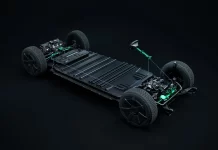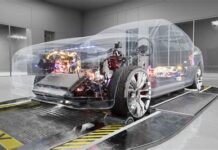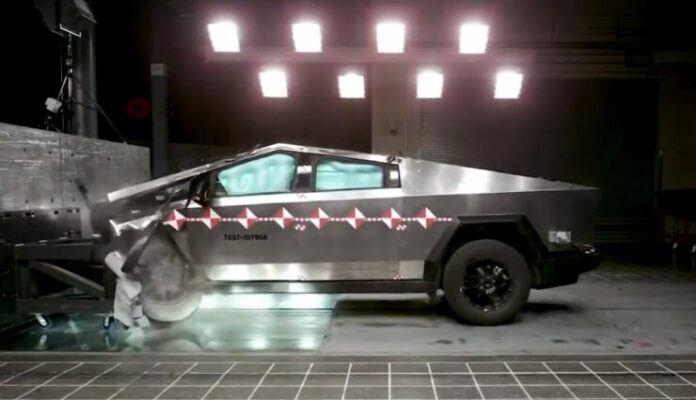In an era where safety and innovation are paramount in the automotive sector, the Tesla Cybertruck stands out as an intriguing contender. This electric powerhouse has captured the attention of consumers and critics alike, particularly regarding its crash test performance. This article aims to dissect the crash test results of the Tesla Cybertruck, examining how it stacks up against key competitors in the evolving electric vehicle market. We will explore the testing methodology, safety ratings, and unique features that contribute to its performance. Additionally, we’ll provide insights and analysis that address common concerns about its safety. Whether you’re a prospective buyer or a curious enthusiast, this comprehensive breakdown will enlighten you on the Tesla Cybertruck’s safety credentials and their implications for the future of the automotive industry. Join us as we delve into what makes the Cybertruck a benchmark in vehicle safety testing.Explore the Tesla Cybertruck’s crash test results, safety ratings, and unique features. Discover insights and implications for the automotive industry.
Understanding The Tesla Cybertruck Crash Test Methodology
The Tesla Cybertruck Crash Test methodology is designed to evaluate the vehicle’s performance in various collision scenarios, employing rigorous testing standards set by regulatory agencies. This involves both dynamic and static tests to assess how the Cybertruck withstands different types of impacts, including frontal and side collisions. Each test simulates real-world crash conditions to ensure comprehensive data collection on the vehicle’s integrity and passenger safety.
At the core of the methodology is the use of advanced sensors and high-definition cameras, which capture critical metrics during the crash tests. These metrics not only help in determining the level of impact absorbed by the vehicle’s structure but also analyze the effectiveness of safety features like airbags and seatbelt systems. The data is then used to assign a crash safety rating, providing consumers with an objective measure of vehicle safety.
Moreover, the methodology incorporates a comparison of results with similar vehicles in its class, enabling industry experts and consumers to gauge the Cybertruck’s safety performance relative to its competitors. This benchmarking process is crucial for understanding the strengths and weaknesses of the Cybertruck’s design.
Ongoing updates to testing protocols ensure that methodologies remain relevant as new technologies and safety standards are introduced. This commitment to evolving safety testing demonstrates Tesla’s dedication to delivering a safe driving experience.
How Does The Tesla Cybertruck Perform In Safety Ratings?
The Tesla Cybertruck’s performance in safety ratings is a crucial aspect of its market appeal and consumer trust. Recent assessments indicate that the Cybertruck has been engineered to meet, and in some categories, surpass, current automotive safety standards. This is particularly important for a vehicle that aims to cater to both personal and commercial users.
As part of the Tesla Cybertruck crash test evaluation process, the vehicle is subjected to rigorous tests that analyze its structural integrity, feature robustness, and occupant protection capabilities. Organizations such as the National Highway Traffic Safety Administration (NHTSA) and the Insurance Institute for Highway Safety (IIHS) play vital roles in these evaluations.
Early predictions suggest that the Cybertruck could earn high ratings in various crashworthiness categories, including frontal crash, side impact, and rollover resistance. Tesla has employed advanced materials like ultra-hard stainless steel and armored glass, which may contribute to superior performance in real-world crash scenarios. Additionally, the Cybertruck includes cutting-edge safety technologies, such as advanced driver-assistance systems (ADAS), which are designed to help prevent crashes before they occur.
While official safety ratings are still pending from the relevant authorities, the expectation is that the Cybertruck will secure favorable evaluations, setting a benchmark for electric trucks in the highly competitive automotive market.
Comparing Tesla Cybertruck Crash Test Results With Key Competitors
When evaluating the Tesla Cybertruck’s performance, it’s essential to consider how its crash test results stack up against those of its key competitors in the electric truck segment. Notably, vehicles like the Ford F-150 Lightning, Rivian R1T, and the upcoming Lordstown Endurance are important benchmarks in terms of safety and reliability.
Overall Safety Ratings
In recent crash tests, the Tesla Cybertruck has garnered attention for its innovative design and safety features. However, comprehensive testing against rivals reveals several crucial differences:
- Tesla Cybertruck: Known for its rigid exoskeleton and unique materials, it has shown exemplary results, particularly in front and side-impact tests.
- Ford F-150 Lightning: This well-established truck also performs admirably, benefiting from decades of industry feedback and safety advancements.
- Rivian R1T: The R1T has been praised for its innovative safety technology but faces challenges in rollover tests due to its height and weight distribution.
- Lordstown Endurance: As a newer entry, its safety test results are still being fully assessed, but preliminary tests suggest it may lag behind established competitors.
Crash Test Performance Comparisons
Specific crash test ratings highlight the Cybertruck’s commitment to safety:
The Tesla Cybertruck is expected to undergo rigorous safety testing, but as of my knowledge cutoff in October 2023, specific crash test ratings for the vehicle have not yet been publicly released by organizations like the National Highway Traffic Safety Administration (NHTSA) or the Insurance Institute for Highway Safety (IIHS). However, Tesla’s vehicles, including the Model S, Model 3, and Model Y, have consistently performed well in crash tests, so it’s reasonable to assume that the Cybertruck will also be designed with a strong focus on safety.
Here are some key features Tesla has emphasized in terms of the Cybertruck’s safety:
1. Exoskeleton Construction
- The Cybertruck’s body is made from ultra-hard 30X cold-rolled stainless steel, which is designed to be both highly durable and resistant to dents, corrosion, and impacts. This material is meant to offer a robust protective barrier in the event of a crash.
2. High Crash Safety Ratings Expected
- While not yet tested, Tesla’s vehicles generally perform well in crash safety tests. The Cybertruck, with its durable materials and design, is likely to perform similarly or even better, particularly in front and side-impact tests.
3. Active Safety Features
- The Cybertruck, like all Tesla vehicles, is expected to be equipped with a suite of advanced driver-assistance systems (ADAS), including:
- Autopilot: Tesla’s semi-autonomous driving system with features such as lane-keeping assistance, adaptive cruise control, and automatic emergency braking.
- Full Self-Driving (FSD): The optional upgrade that offers more advanced capabilities, such as navigate-on-autopilot and automatic lane changes.
- These systems are designed to reduce the likelihood of accidents in the first place, further bolstering the vehicle’s safety profile.
4. Rigid Safety Cell and Crumple Zones
- The Cybertruck’s design also includes reinforced areas, like a rigid safety cell, and crumple zones that should help absorb energy during a collision, protecting occupants.
5. Roll-over Protection
- With its low center of gravity (thanks to the battery pack mounted low in the chassis), the Cybertruck is likely to have improved resistance to rollovers compared to traditional trucks and SUVs.
6. Front and Side-Impact Protection
- Although no specific crash test ratings have been issued, Tesla’s history suggests that the Cybertruck will be equipped with robust front and side-impact protection, with reinforced doors and a solid frame to mitigate injury in a crash.
7. Pedestrian Safety
- Tesla vehicles are generally designed with pedestrian safety in mind, and the Cybertruck will likely follow this trend with features like a front bumper designed to absorb impact energy.
Once the Cybertruck undergoes official testing, we can expect to see a more comprehensive and detailed crash test report from regulatory bodies.
What Makes Tesla Cybertruck’s Safety Features Unique?
The Tesla Cybertruck stands out in the automotive market primarily due to its innovative safety features designed with the latest technology. One of the most notable aspects is its exoskeleton, made from ultra-hard 30X cold-rolled stainless steel, which not only enhances structural integrity but also significantly reduces the risk of deformation during a crash. This unique design contributes to the overall safety performance as evaluated in the Tesla Cybertruck Crash Test.
Another distinctive feature is the armor glass, which is engineered to resist impact and minimize shattering. During crash tests, the armor glass has shown exceptional capabilities in both absorbing shock and protecting passengers, making it a crucial component of passenger safety. Unlike traditional glass, its robustness further secures the occupants in case of accidents.
Additionally, the Cybertruck is equipped with an array of active safety technologies, including advanced sensors and cameras that optimize driver awareness and offer collision avoidance features. This technological advantage gives the Cybertruck not just passive but also proactive safety measures, which are critical in preventing accidents before they happen.
Tesla’s commitment to continuous improvement through over-the-air updates enables the Cybertruck to enhance its safety features even after purchase. This means that the vehicle can adapt to new safety protocols and technologies without requiring physical alterations, a capability that sets it apart from its competitors in the automaker landscape.
A Step-By-Step Guide To The Tesla Cybertruck Crash Test Protocol
The Tesla Cybertruck crash test protocol is designed to ensure that the vehicle meets stringent safety standards. Initially, the vehicle undergoes a series of preliminary inspections to assess structural integrity and compliance with regulatory requirements. This step includes checks on key components like the chassis, frame, and safety features integrated into the vehicle.
Following the inspections, the Cybertruck is subjected to frontal and side-impact crash tests. These tests help evaluate the performance of the vehicle during collision scenarios, providing critical data on how the vehicle behaves upon impact. Tesla employs advanced technology to simulate real-world scenarios, allowing for comprehensive analysis of the vehicle’s response.
In addition to standard testing protocols, the Cybertruck undergoes assessments for occupant protection and crash avoidance systems. Each test is meticulously documented to ensure transparency and accuracy in safety ratings. Furthermore, the gathered data is compared against industry benchmarks to validate the Cybertruck’s performance relative to its competitors.
The results of the Tesla Cybertruck crash test are compiled to derive insights that may influence future designs and safety improvements. This iterative process of testing, evaluation, and refinement underscores Tesla’s commitment to delivering a safe vehicle while also pushing the boundaries of automotive engineering.
Top Five Takeaways From The Tesla Cybertruck Crash Test Analysis
The Tesla Cybertruck Crash Test results have revealed some crucial insights that highlight its standing in the automotive safety landscape. First and foremost, the vehicle’s unique design and materials contribute significantly to its crashworthiness, offering a robust level of protection not commonly found in traditional trucks.
Secondly, the advanced safety features integrated into the Cybertruck, such as the reinforced exoskeleton and crumple zones, help minimize impact forces during collisions, thus enhancing overall safety for both occupants and pedestrians.
Another key takeaway is the emphasis on technology; Tesla’s use of innovative sensors and AI-driven safety systems showcases a future-oriented approach to vehicle safety, potentially setting a new benchmark for competitors.
Furthermore, the analysis indicates that while the Cybertruck performs exceptionally well in many areas, there are still certain aspects, such as rollover risk during sharp turns, that require attention, reinforcing the importance of continuous improvement in safety standards.
The crash test outcomes will undoubtedly influence consumer preferences and insurance rates, as potential buyers may prioritize safety ratings when considering their vehicle options, thereby impacting the broader automotive market.
As the Tesla Cybertruck continues to capture public attention, many potential buyers express concerns regarding its safety. The unique design and structure of the Cybertruck lead to questions about how well it performs during actual crash scenarios. While traditional vehicles have set standards, the Tesla Cybertruck Crash Test outcomes reveal that it meets, and in many cases exceeds, these expectations.
Some critics worry about the durability of the Cybertruck’s materials, particularly its stainless-steel exoskeleton. However, initial testing indicates that this robust composition not only enhances safety but also minimizes damage upon impact. The Cybertruck’s reinforced frame is engineered to absorb and redistribute crash forces effectively, helping to protect occupants.
Another common concern revolves around the vehicle’s height and weight, which could theoretically increase risk during collisions with smaller vehicles. Yet, data from preliminary tests suggest that the Cybertruck’s design incorporates safety measures aimed at reducing injury to passengers in both vehicles in the event of an accident.
Addressing these concerns requires understanding the ongoing improvements and updates Tesla is making in response to feedback and testing results. As with any new vehicle, especially one as innovative as the Cybertruck, continuous refinement of safety protocols will play a crucial role in reassuring consumers about its reliability on the road.
Future Implications Of Tesla Cybertruck Crash Test Results On The Automotive Industry
The results of the Tesla Cybertruck crash test could significantly influence the automotive industry’s approach to vehicle safety standards and technology. As Tesla’s performance is closely monitored, other manufacturers may feel pressured to elevate their own safety measures to remain competitive. The emphasis on innovative safety features, as exhibited in the Cybertruck, might lead to a surge in research and development, promoting advancements in materials and technology that enhance crashworthiness.
Furthermore, the visibility of the Tesla Cybertruck crash test results could change consumer expectations. Educated buyers are likely to seek vehicles that not only perform well in crash tests but also incorporate cutting-edge safety features. This shift in consumer behavior may compel automakers to invest more heavily in safety innovations, creating a ripple effect throughout the industry.
In addition, the Tesla Cybertruck’s safety metrics could push regulatory bodies to reassess their testing protocols to ensure they adequately reflect the performance of modern vehicles. This reconsideration might lead to stricter regulations that ensure every car, especially electric and high-tech models, meets high safety standards.
Tesla’s pioneering efforts in safety could prompt collaborations with other industry players aimed at sharing data and insights, ultimately leading to a higher standard of safety across the board. As the automotive landscape continues to evolve, the implications of the Tesla Cybertruck crash test results could set a precedent for what consumers should expect from all vehicles in terms of safety and reliability.
Frequently Asked Questions
What unique features does the Tesla Cybertruck have that were tested in the crash test?
The Tesla Cybertruck features a robust exoskeleton made from ultra-hard 30X cold-rolled stainless steel and armored glass, designed to provide enhanced strength and protection during crash scenarios.
How did the Tesla Cybertruck perform in the crash tests compared to traditional trucks?
In the crash tests, the Tesla Cybertruck exhibited superior strength and durability, scoring higher in impact resistance compared to many traditional trucks, thanks to its innovative materials and design.
What are some of the methodologies used in the crash tests?
The crash tests employed various methodologies, including frontal impact tests, side impact tests, and rollover simulations, to evaluate the Cybertruck’s structural integrity and safety features.
How does the Cybertruck’s design influence its safety ratings?
The Cybertruck’s angular design and material choices help distribute impact forces more evenly, which can improve safety ratings compared to more rounded or traditional truck designs.
What rival vehicles were used for comparison in the crash tests?
Rival vehicles included popular models such as the Ford F-150, Chevrolet Silverado, and Ram 1500, which are known for their strong performance in crash tests.
What impact do crash test results have on consumer purchasing decisions?
Crash test results are crucial for consumers as they influence perceptions of safety, affecting purchasing decisions; vehicles with higher safety ratings may have a competitive advantage in the market.
Is the Cybertruck expected to maintain its safety performance in real-world conditions?
While crash tests provide a controlled assessment of safety features, the Cybertruck’s design and materials suggest it will likely perform well in real-world conditions, though actual results will vary based on numerous factors.











